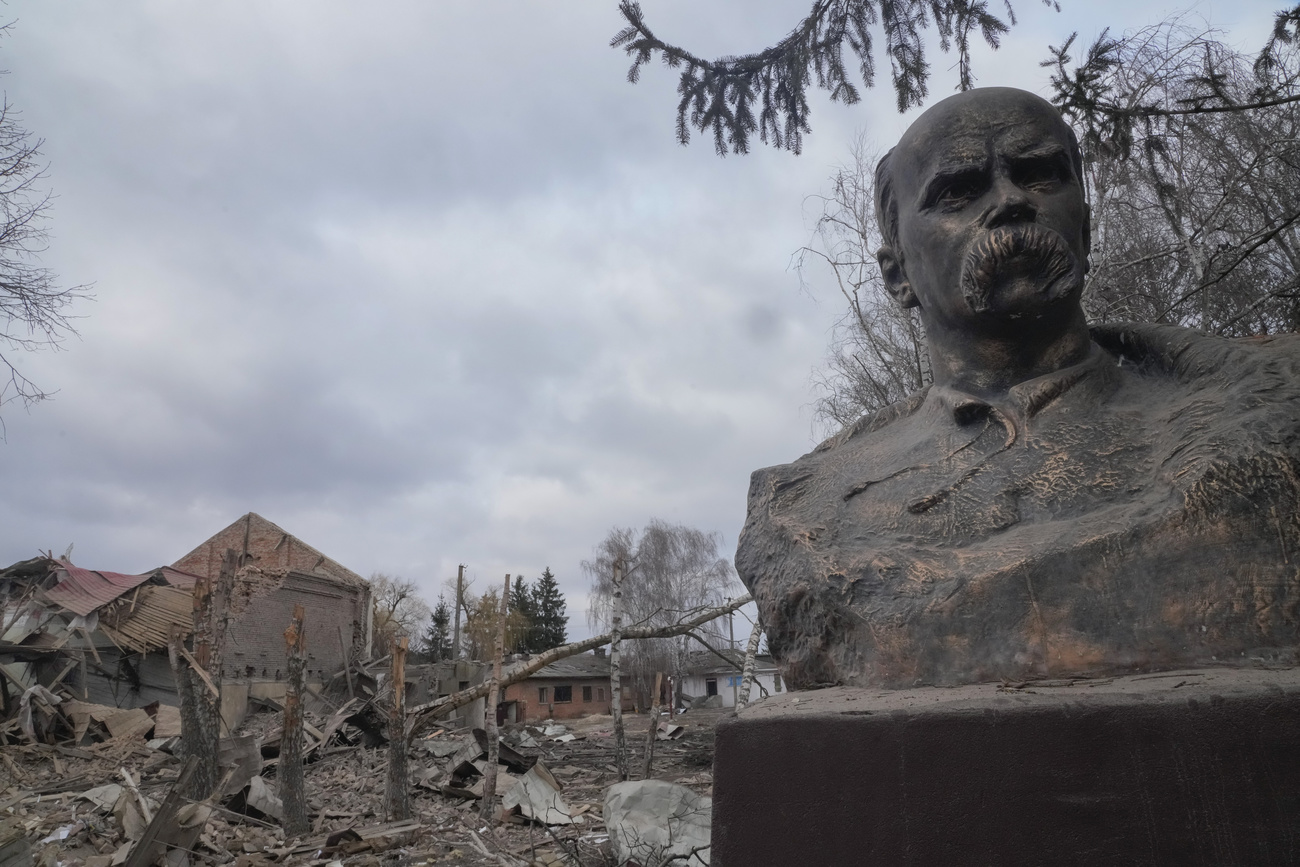
When cultural heritage becomes collateral damage in war

Dozens of churches, historical sites and museums have been damaged by Russia's invasion of Ukraine. The destruction is a reminder that, despite enjoying protection under international law, cultural institutions – like civilian populations – can suffer significant losses in a war.
On the vast expanses of a nature park in canton Vaud, a group of young people and members of the civil protection service hover over a collection of objects that are visibly charred. They carefully move, inspect, photograph and classify the items one by one.
The group are taking part in a training exercise in rescuing artefacts organised by the conservation and restorationExternal link programme of the Arc technical college (HE-Arc). In all, 13 students are learning what to do if disaster strikes in a museum, a library or a building housing archives. This involves work such as separating items that are destroyed beyond repair from those that should be kept for future restoration.

The impact on Ukraine
This type of exercise usually takes place every two years. But on this early spring day, it is happening in a particular context: everyone is thinking about the war in Ukraine, where heritage sites are at risk of serious damage.
The Ukrainian government has done what it can to protect the country’s heritage. Art collections have been stored in safe places. Buildings and items that cannot be moved have been covered with whatever resources are available, including sandbags, tarpaulins, foam and fire-retardant materials.
Despite these efforts, after several weeks of military incursions, Ukraine has suffered losses and damage to its cultural sites. A preliminary list of totally or partially damaged sites drawn up by the UN cultural agency UNESCO at the beginning of April featured 29 religious sites, 16 historical buildings, four museums and four monuments.
In Invankiv, near Kyiv, 25 paintings by the artist Maria Primachenko went up in flames when the local history and art museum was hit in a bombing raid.

International protection
Just like civilian populations, cultural heritage enjoys international protection in armed conflicts.
“Given the collateral damage that was becoming more and more significant in modern warfare, countries began to realise towards the end of the 19th century that heritage needed to be looked after and dealt with at the international level,” says Nathalie Ducatel, a conservation instructor at the HE-Arc.
However, it was the extensive destruction of cultural heritage during the Second World War that led to tangible progress. The Hague Convention for the Protection of Cultural Property in the Event of Armed Conflict, the first international treaty on protecting cultural heritage worldwide, was adoptedExternal link in 1954.
This treaty forbids the use of cultural treasures for purposes that might put them at risk of destruction or damage. It also requires that belligerents abstain from attacking heritage sites. In addition, military personnel must receive training on respecting cultural treasures.
Two additional protocols reinforce these rules. The first bans the export of cultural treasures from occupied territories. The second makes it a crime to deliberately destroy any cultural treasure and establishes a special fund to assist states in protecting their cultural property.
Multiple crimes against cultural heritage
Yet the Hague Convention is not always respected, as recent conflicts have shown.
“At the end of the conflict in Yugoslavia, the belligerents deliberately shelled places identified as heritage sites,” says Ducatel. “People thought that this kind of action was a thing of the past after the Second World War. So what happened in Yugoslavia came as a shock.”
Crimes against cultural heritage have continued unabated. One example is the destruction by the Taliban of the giant Buddha figures at Bamiyan in Afghanistan in 2001. Other examples include the destruction of UNESCO World Heritage Site Palmyra by the militant group Islamic State during the Syrian civil war, and the wholesale looting of archaeological treasures in the museums of Iraq.
“When there is an attack on heritage, the idea is to target something that is especially precious to a nation – its collective memory and identity,” says Ducatel.
These examples show that having an international convention is not enough to protect heritage any more than civilian populations – nor can it guarantee that those responsible for destroying cultural sites will be prosecuted or sued for damages.
That said, having an international legal framework in place is still valuable.
“Clearly we will never be able to prevent all destruction and looting,” says Ducatel. “But the fact that these rules exist dampens the market for illegally acquired artefacts in countries like Switzerland.”
The Federal Office of Culture is providingExternal link CHF750,000 ($802,000) to museums and institutions in Switzerland so that they can accept cultural treasures from Ukraine for temporary storage and safe-keeping.
Switzerland is also offering financial support to international organisations, including the United Nations culture and education organisation, UNESCO, and to Swiss institutions and private groups that are helping Ukrainians to protect their cultural heritage from destruction or theft.
Source: press release by Federal Office of CultureExternal link
Translated from French by Terence MacNamee

In compliance with the JTI standards
More: SWI swissinfo.ch certified by the Journalism Trust Initiative


























You can find an overview of ongoing debates with our journalists here . Please join us!
If you want to start a conversation about a topic raised in this article or want to report factual errors, email us at english@swissinfo.ch.